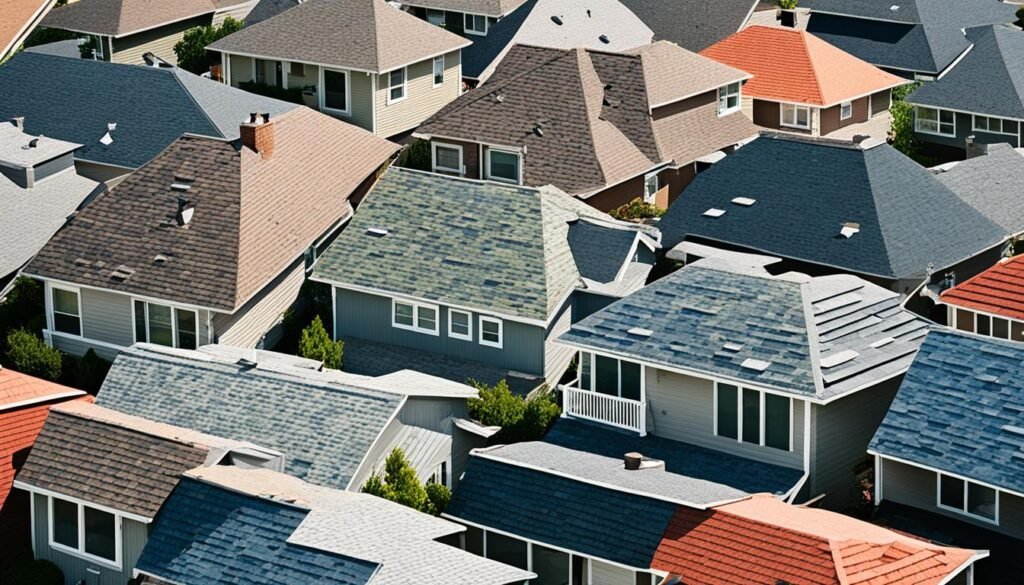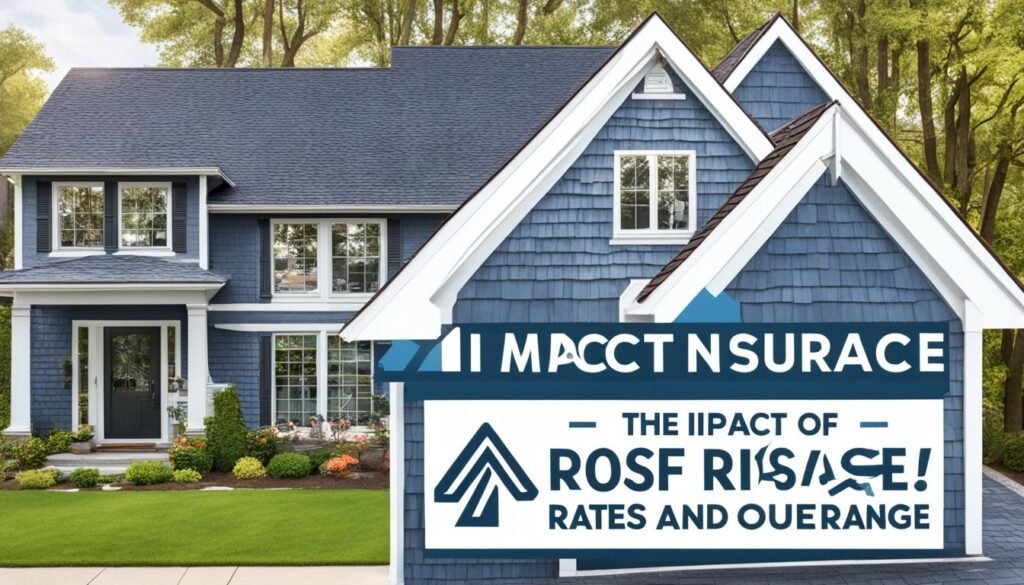A roof that’s 20 years old or more might not get you full coverage. Or, it might only be covered for what it’s worth today. Insurance companies look closely at your roof’s age when setting policy and rates. As your roof gets older, it gets more costly to replace. Insurers see this as a bigger risk, which can raise your rates.
Key Takeaways
- Roofs 20 years old or more may be ineligible for full coverage or only covered for actual cash value.
- Insurers factor roofing material and type into their rebuild cost calculations.
- Newer roofs typically result in better home insurance rates.
- Insurers may require a roof inspection for homes with 20+ year old roofs before offering coverage.
- Older roofs may only be covered for actual cash value, leaving homeowners responsible for replacement costs.
The Importance of Roof Age in Home Insurance
Your roof’s age and condition are big deals for home insurance. Insurance companies look carefully at how long your roof will last and its current state. They do this to set your coverage and what you’ll pay. Knowing how your roof’s age affects your insurance is key. It helps you choose the right way to look after your home.
Roofing Material Lifespan
Each type of roof material has its own lifespan. For example, asphalt shingles can last between 15 and 30 years. Meanwhile, metal roofs are the kings and queens of longevity, lasting 50 to 75 years. And wood shakes fall somewhere in the middle, lasting about 35 to 40 years. As roofs get older, they face more wear and tear. This makes them more likely to get damaged, leading to possible insurance claims.
Roof Condition and Insurability
Roof condition matters a lot when it comes to insurance. If your roof’s over 20 years, insurance might ask for a pro’s checkup. You might also get coverage for only what your roof is worth now, not its full replacement cost. This could mean extra costs for you.
Keeping your roof in good shape avoids some of these headaches. Regular checks and timely fixes can extend its life. This keeps your insurance costs lower and your coverage better. Insurance companies see a well-taken-care-of roof as less of a risk.
| Roofing Material | Lifespan (Years) | Average Cost per Square |
|---|---|---|
| Asphalt Shingles | 15-30 | $100 – $150 |
| Concrete Tile | 50+ | $150 – $250 |
| Clay Tile | 100+ | $800 – $1,800 |
| Wood Shake | 35-40 | $250 – $600 |
| Slate | 125-200 | $800 – $1,800 |
| Metal | 40-70 | $120 – $900 per panel |

“The age and condition of your roof are essential factors that insurance providers consider when underwriting your homeowners policy.”
Roof Age Insurance Impact on Rates and Coverage
As your roof gets older, your insurance rates might go up. At the same time, your coverage could go down. Older roofs pose more risk in the eyes of insurance companies.
Because of this risk, they might not cover the full cost to replace your roof. Instead, they pay the actual cash value, factoring in its age and wear.
Actual Cash Value vs Replacement Cost
The difference in cost between a new roof and the insurance payout can be a big shock. This is especially true for older roofs. Knowing about this difference helps you be ready for what your insurance might do.
In 2022, Georgia’s insurance carriers paid out more than they got in premiums. This leads to losses, as it did in 2021. The main problem comes from high costs to repair or replace homes.
So, insurance companies are making a few changes. They are looking closely at roofs. Some now refuse to insure roofs over 10 years old. The biggest firm in the US won’t cover roofs older than 5 years.
More policies are now paying out based on the roof’s age sooner, typically after 10 years. Carriers are also strict about the roof’s condition. They might drop your policy if they find problems, like hanging branches or storm damage.
Another thing they check is your past insurance claims. Homes with lots of claims might pay more or have a harder time getting insurance. To keep your rates down, take good care of your roof and avoid filing unnecessary claims.
| Roofing Material | Lifespan | Insurance Impact |
|---|---|---|
| Metal | 40-70 years | Lower premiums due to fire resistance and durability |
| Asphalt Shingles | 15-30 years | May not offer the best protection against severe weather, leading to higher premiums |
| Slate or Tile | 50-100 years | Highly durable but expensive to replace, may result in moderate premium reductions |
| Wood Shingles | 20-40 years | Prone to fire damage, can result in higher premiums unless treated with fire-resistant coatings |
Rates and coverage changes with roof age and other factors. Your roof’s condition and the place you live matter too. Keeping your roof in good shape can help lower your insurance costs.
It’s wise to talk with an insurance expert. They can guide you on picking the right insurance for your home.

Maintaining an Older Roof for Insurance Purposes
If your home’s roof is getting older, you can still keep it in good shape. This helps you maintain your insurance. Try regular roof checks, quick fixes for any damage, and keep up with maintenance. These efforts show insurance companies your roof is still solid. Doing this might prevent your rates from going up or your coverage from being reduced. Even though your roof is older, you can still keep it well protected.
Upgrading your roof with better materials could also save you money. Getting durable materials means your home can withstand storms better. Plus, it could raise the value of your property. A strong roof not only protects you but pays off in the long haul.
Older roofs are seen as more risky by insurance companies. So, taking care of your roof is very important. These steps can keep your policy in good shape as your roof gets older.
Key Roof Maintenance Tips
- Schedule regular roof inspections to identify and address any issues early on.
- Promptly repair any roof damage, such as missing or cracked shingles, to prevent further deterioration.
- Keep up with routine roof maintenance, like cleaning gutters, trimming overhanging trees, and ensuring proper ventilation.
- Consider upgrading to more durable roofing materials that may qualify for insurance discounts.
“Proactive roof maintenance is key to maintaining your home’s insurability as your roof ages.”
Following these great ways to care for your roof is a smart move. It keeps your roof, home, and insurance in good shape for the future.
Conclusion
The age of your roof matters a lot to insurance companies. They look at how old your roof is when figuring out your insurance coverage and cost. An older roof can be costly to replace and insure. This might mean higher rates or less coverage.
It’s smart to know how long different roofing materials last. This way, you can be ready for what an aging roof might mean for your insurance. Learning about the coverage types, like actual cash value and replacement cost, is important too.
Keeping your roof in good shape through regular checks and repairs is helpful. This can make your home more insurable. It might even get you discounts. Using the best roofing materials helps, as does keeping good records of any new roofs.
Being on top of your roof’s condition and knowing how it affects your insurance is key. Taking steps to care for your roof can keep your insurance costs from climbing. This is important as your roof gets older.
FAQ
How does the age of my roof impact my homeowners insurance?
What is the expected lifespan of different roofing materials?
How does the condition of my roof affect its insurability?
What’s the difference between actual cash value and replacement cost coverage for my roof?
How can I maintain an older roof to keep it insurable?
Source Links
- https://www.progressive.com/answers/how-roof-type-impacts-insurance/
- https://www.tdi.texas.gov/tips/replacing-your-roof.html
- https://www.planforfreedom.com/how-much-does-a-new-roof-save-on-home-insurance-in-texas/
- https://quotewizard.com/home-insurance/how-your-roof-impacts-homeowners-rates
- https://www.bankrate.com/insurance/homeowners-insurance/roof-insurance/
- https://gannonassociates.com/2024/04/03/how-your-roof-impacts-your-insurance/
- https://www.whiteoakis.com/personal-insurance/home-insurance/property-insurance-changes-in-georgia-and-how-they-affect-you/
- https://www.cbiz.com/insights/articles/article-details/impact-of-roof-age-on-commercial-property-insurance-revealed-property-casualty
- https://litespeedconstruction.com/does-the-age-of-a-roof-affect-homeowners-insurance-what-affects-my-home-insurance-rates/
- https://www.qeiroof.com/roof-age-and-insurance/
- https://roof-troopers.com/blog/age-of-roof-and-insurance/
- https://bestroofhelp.com/blogs/roof-age-affect-insurance-rates/
- https://ridgelineconstructionhsv.com/how-does-the-age-of-your-roof-impact-insurance-in-alabama/
- https://bitnerhenry.com/understanding-the-impact-of-roof-age-on-commercial-property-insurance/
- https://porch.com/home-insurance/roof-age-home-insurance-rates
